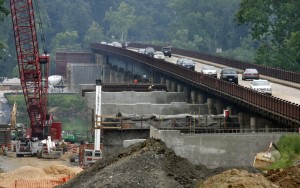VDOT will spend nearly $2.3 billion to upgrade the state’s bridges over the next six years.
“We’re going to spend $564 million in additional state money on bridge reconstruction and rehabilitation,” said state Transportation Secretary Sean T. Connaughton. “This isn’t just about infrastructure. This is about ensuring the public safety.”
The goal is to make sure the percentage of structurally deficient bridges remains less than 8 percent of the state’s nearly 21,000 bridges and culverts.
“There’s a large backlog of bridge maintenance projects that we’re now going to be able to get to,” Connaughton said at the Commonwealth Transportation Board meeting Wednesday in Richmond.
This year, 7.5 percent of Virginia bridges were rated structurally deficient, the Virginia Department of Transportation said.
Nationally, 11 percent of 607,000 road bridges were considered in poor repair, according to figures from the Federal Highway Administration. The average U.S. bridge is 42 years old.
VDOT says that bridges slated to be replaced as structurally deficient in the Richmond region include those carrying Interstate 64 over Airport Drive in Henrico County, Interstate 195 over the Powhite Parkway in Richmond, U.S. 1 over railroad tracks at Bellwood in Chesterfield County, and state Route 13 over Sallee Creek in Powhatan County.
The funds for accelerated bridge work are part of the state’s $17.6 billion allocation for transportation programs for the fiscal year that begins July 1 and continues through the fiscal year that ends June 2019.
The six-year transportation program, including new funding sources for Northern Virginia and Hampton Roads, is $6.2 billion larger than last year’s approved plan, a 54 percent increase. The state Transportation Board approved the new six-year program Wednesday.
The funding increase largely springs from revenue the General Assembly provided this year, the first significant infusion of money into the state’s cash-strapped transportation system since 1986.
Not everyone was pleased with the spending plan.
“This program will be remembered for squandering billions of tax dollars while making Virginia’s patterns of development less efficient, more oil dependent and less competitive,” said Stewart Schwartz, executive director of the Coalition for Smarter Growth.
The plan includes a number of “wasteful mega-projects that have been strongly criticized as unnecessary,” Schwartz said, citing $1.4 billion for the new U.S. 460; $244 million for the Charlottesville Bypass project; the $1 billion-plus North-South Corridor highway in Northern Virginia; and the $2.8 billion Coalfields Expressway in Southwest Virginia.
“We are shocked by the lack of discussion of the spending priorities in the six-year plan, by the failure to tie the program to specific policy goals, and the assumption that simply adding road capacity will solve our transportation problems,” Schwartz said.
The May 23 collapse of an Interstate 5 bridge in Mount Vernon, Wash., has drawn national attention on the issue of bridge safety. In the I-5 incident, a 160-foot span of the four-lane bridge collapsed into the Skagit River after a tractor-trailer with an oversized semitrailer struck the span’s overhead truss structure.
To eliminate the nation’s deficient bridge backlog by 2028, the U.S. needs to invest $20.5 billion annually, though only $12.8 billion is being spent currently, the American Society of Civil Engineers said in its 2013 Report Card for America’s Infrastructure.
According to the American Association of State Highway and Transportation Officials, being classified as structurally deficient does not mean a bridge is unsafe.
If a Virginia bridge’s structural rating sinks too low, state highway officials post a lower weight limit on it and increase its frequency of inspections. In the worst case, VDOT closes bridges in poor condition.
Photo courtesy of P. Kevin Morley.

